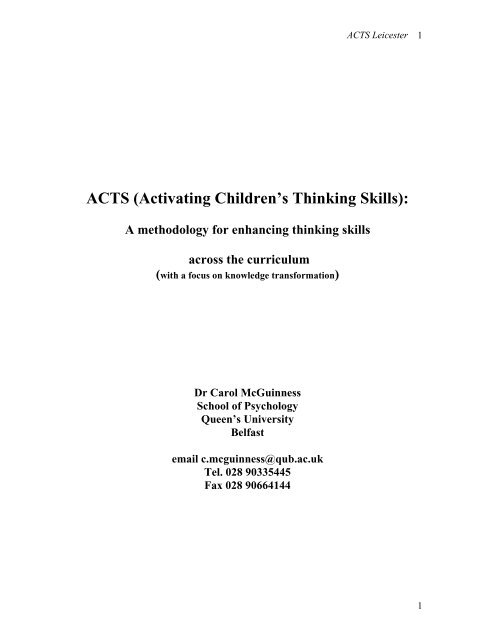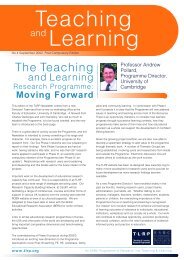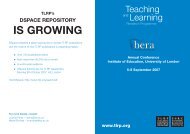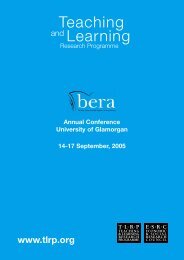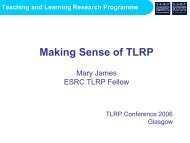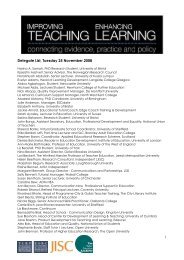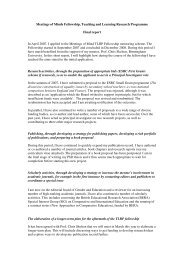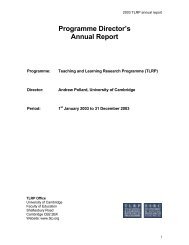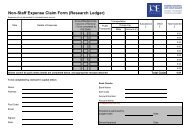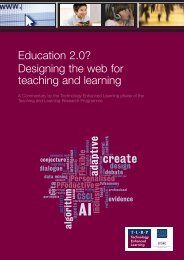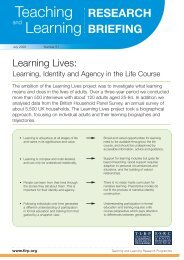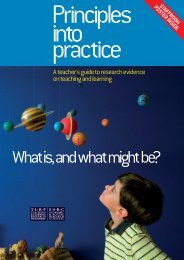Activating Children's Thinking Skills - Teaching and Learning ...
Activating Children's Thinking Skills - Teaching and Learning ...
Activating Children's Thinking Skills - Teaching and Learning ...
Create successful ePaper yourself
Turn your PDF publications into a flip-book with our unique Google optimized e-Paper software.
ACTS Leicester 1ACTS (<strong>Activating</strong> Children’s <strong>Thinking</strong> <strong>Skills</strong>):A methodology for enhancing thinking skillsacross the curriculum(with a focus on knowledge transformation)Dr Carol McGuinnessSchool of PsychologyQueen’s UniversityBelfastemail c.mcguinness@qub.ac.ukTel. 028 90335445Fax 028 906641441
ACTS Leicester 2Paper to be presented at ESRC TLRP First Programme Conference,9/10 November 2000This paper sets out to elaborate on three points:• Firstly, to give a brief overview of the ACTS project, at a fairly factual level,explaining what it is, what it set out to achieve, how it was run <strong>and</strong> so on.• Secondly, in the context of the “knowledge transformation” theme of the conference,to examine what kinds of knowledge were transformed - or at least considered fortransformation - during the course of the project.• Finally, to identify the kinds of difficulties the project encountered <strong>and</strong> to interpretthese in knowledge transformation terms.What is ACTS?The purpose of ACTS was to promote the development of thinking skills inordinary classrooms in Northern Irel<strong>and</strong> at upper primary level (Key Stage 2). Morespecifically, we worked in partnership with a small group of Key Stage 2 teachers to trialan infusion methodology across the curriculum, to produce a h<strong>and</strong>book of examplelessons, <strong>and</strong> to gauge teachers’ initial reactions <strong>and</strong> evaluations of the methodology.In contrast to approaches to teaching thinking which target either generic thinkingskills, e.g., Instrumental Enrichment (Feuerstein et al., 1980) or subject specific thinking,e.g., Cognitive Acceleration through Science Education (Adey & Shayer, 1994), ACTSadopted an infusion methodology. An infusion approach seeks to identify contexts acrossthe curriculum where particular thinking skills can be developed; for example, causalreasoning in a science lesson, classification of mathematical shapes, decision-makingwith reference to personal decisions or to fictional/historical characters. The benefitsof infusion were seen as - matching thinking skills directly with topics in the curriculum;invigorating content instruction leading to deeper underst<strong>and</strong>ing; using classroom time2
ACTS Leicester 3optimally; directly supporting teaching for thoughtfulness across the curriculum; <strong>and</strong>facilitating transfer <strong>and</strong> reinforcement of learning. Moreover, the approach seemedparticularly appropriate for primary level where the teacher is in charge of the wholecurriculum in a classroom. However, the method is not confined to primary level <strong>and</strong> hassince been successfully adopted by a group of teachers working in subject areas at postprimarylevel. It is also very similar to strategies adopted by Viv Baumfield <strong>and</strong> DavidLeat at the University of Newcastle, e.g., <strong>Thinking</strong> through Geography, (Leat, 1998).Most attempts to teach thinking are based on some formal analysis of thecomponents of thinking. Irrespective of their precise theoretical foundation, what theyare all attempting to do is to develop the pupil’s thinking to a qualitatively higher level -to change thinking into a higher gear. Some approaches draw clearly on one particulartheoretical viewpoint about the nature of thinking <strong>and</strong> cognitive development. Forexample, the CASE/CAME family of curriculum materials are clearly positioned in aPiagetian framework (Adey & Shayer, 1994); Philosophy for Children is founded on theimportance of philosophical inquiry, critical thinking <strong>and</strong> Socratic dialogue (Lipman,1980; Fisher, 1998) <strong>and</strong> Gardner’s work is derived from his theory of multipleintelligences (Gardner, 1993). Other approaches have more eclectic theoreticalorientations (Marzano et al., 1988). For a fuller analysis of the theoretical orientations ofthinking skills approaches <strong>and</strong> their associated teaching methods, see McGuinness(1993), McGuinness (1999), McGuinness & Nisbet (1991).Because of the infusion approach, ACTS opted for a more general theoreticalframework <strong>and</strong> drew particularly on Swartz & Parks’ (1994) taxonomy of thinking skills.Examples of the types of thinking within the ACTS framework are (<strong>and</strong> this is not anexhaustive list):• Sequencing, ordering information; sorting, classifying, grouping; analysing,part/whole relationships, comparing <strong>and</strong> contrasting. This group can be characterisedas searching out order <strong>and</strong> imposing meaning on information.• Making predictions, hypothesising; drawing conclusions, justifying conclusions,distinguishing fact from opinion; determining bias, checking the reliability of3
ACTS Leicester 4evidence; relating causes <strong>and</strong> effects. This group can be characterised as criticalthinking, questioning/scrutinising information <strong>and</strong> making judgements about it.• Generating new ideas; brainstorming; formulating own points of view, combiningideas, recognising <strong>and</strong> using analogies. This group can be characterised as creativethinking.• Problem-solving; defining problems, thinking up different solutions, testingsolutions.• Planning; setting up sub-goals, monitoring progress.• Making decisions; generating options, weighing up the pros <strong>and</strong> cons, choosing acourse of action.(Problem-solving <strong>and</strong> decision-making draw on thinking components from the earliergroupings.)Having identified an appropriate thinking skills’ taxonomy, ACTS systematised aset of teaching strategies - a thinking skills’ pedagogy - which were identified in previousstudies as characteristic of successful learning environments (e.g., De Corte, 1990). Inparticular, we presumed that thinking was a “hidden skill” <strong>and</strong>, as such, needed to bemade explicit through a variety of strategies. Unlike other sorts of skills where thecomponent parts are more overt (e.g., motor skills), the components of thinking are notalways clearly “visible” to learners. Hence, strategies were adopted to make thecomponents of thinking more explicit, to develop a language for talking about thinking,to model <strong>and</strong> coach novice learners in the ways of good thinking. For example, wedeveloped strategies to help teachers <strong>and</strong> pupils develop a vocabulary for talking aboutthinking, to use thinking diagrams to clarify the steps or components in a thinkingprocess, to make pupils’ thinking more explicit through discussion, reflection <strong>and</strong>collaborative enquiry. In general, we advocated taking a metacognitive perspective.Figure 1 is an overview.Putting thinking on the agenda4
ACTS Leicester 5Making thinking skills explicitFeedback, coaching, scaffolding<strong>Thinking</strong> <strong>Skills</strong>’PedagogyDispositions for thinking<strong>Thinking</strong> classroomsDeveloping a thinkingvocabularyReflection, discussionmetacognition, transferRunning the project: Seventeen upper primary teachers participated in the project.They attended 6 training days, distributed over 6 months, <strong>and</strong> scripted some of their ownlessons for the h<strong>and</strong>book. After an initial 2-day induction to the method (which includedmodelling infusion lessons), each teacher designed lessons, experimented in their ownclassrooms, recorded their results <strong>and</strong> returned the following month to discussachievements <strong>and</strong> difficulties <strong>and</strong> to exchange good practice. On these review days,additional thinking skills were introduced, teachers were given feedback, <strong>and</strong> moreadvanced questioning <strong>and</strong> teaching-for-transfer skills were discussed. By the end of theyear, over 100 infusion lessons had been taught to some 300 pupils; 24 of those lessonswere included in the h<strong>and</strong>book <strong>and</strong> they illustrate how 10 different thinking skills can betaught in nine areas of the Northern Irel<strong>and</strong> Curriculum .Evaluation: The primary purpose of the project was to develop the methodology,produce the h<strong>and</strong>book <strong>and</strong> to gauge initial reactions of teachers <strong>and</strong> students; children'slearning gains were not monitored at this stage.However, at the end of the year teachers completed an 18-item open-endedquestionnaire about ACTS. Their evaluations of the impact of ACTS on the pupils <strong>and</strong>themselves were very positive. For example, all teachers identified benefits for children'sthinking. They referred to children's greater reasoning powers <strong>and</strong> increased creativity,their ability to clarify their thinking processes, to see links between different subjectareas, <strong>and</strong> to be more structured <strong>and</strong> focused in their approach to thinking. With regardto themselves, teachers noted that the approach had sharpened their own concept of5
ACTS Leicester 6thinking skills, enabled them to review their schemes of work <strong>and</strong> encouraged moreeffective planning. Some teachers emphasised the across-the-curriculum effects <strong>and</strong>noted changes in the nature of classroom interaction, that there was an increased level ofinteraction, that group work was more structured, there was more open discussion <strong>and</strong>sharing of ideas <strong>and</strong> that children expected to be "pushed" more.Time was identified as the main constraint. Much of the problem was attributedto relative inexperience with the approach which required more planning <strong>and</strong> pre-classpreparation. The requirement to design lessons which matched topics with appropriatethinking skills was not easy. Teachers also commented that thinking skills lessons oftenwent on for longer than initially planned, <strong>and</strong> that they had to be careful to allow time forthinking <strong>and</strong> not jump in with ready-made answers. <strong>Children's</strong> main difficulty was theabsence of an adequate language for talking about thinking.All teachers commented positively on how useful the ACTS methodology hadbeen for their continuing professional development. All were very experienced teachersyet they commented that "it was a refreshing focus on the nature of learning", "it mademe rethink the way that we, as teachers, teach", "I was delighted to find something new","it encouraged self-evaluation of my own teaching style".As is clear from the above, teachers were very satisfied overall with the ACTSmethodology. They quickly adapted the method to their own teaching style <strong>and</strong> needs(one of the strengths of the approach). Even within a short time they could see benefitsfor the children's thinking, for their own teaching, <strong>and</strong> for the classroom in general.From a training point of view, one of the primary difficulties with the infusionmethodology was enabling teachers to sharpen their underst<strong>and</strong>ing of thinking skills, tokeep the twin perspectives of thinking skill <strong>and</strong> content objectives simultaneously inview, <strong>and</strong> to develop <strong>and</strong> sustain the metacognitive perspective.In the context of developing the infusion methodology, it became increasinglyclear that developing children's thinking goes far beyond an underst<strong>and</strong>ing of howchildren learn. Issues to do with curriculum design, availability of curriculum materials,the nature of pedagogy, teachers' beliefs about learning <strong>and</strong> teaching as well as theirprofessional development came to the fore. Perhaps it was not surprising that theemphasis in the ACTS project shifted from thinking-as-a-skill to concepts such as6
ACTS Leicester 7thinking curriculum, thinking classrooms <strong>and</strong> schools for thought. (For a fuller review ofthe ACTS project, see McGuinness, 2000 <strong>and</strong> McGuinness et al., 1997.)Knowledge Transformation: Lessons.......?What did we learn with regard to the transformation of knowledge about thinkingskills into effective teaching <strong>and</strong> learning practices? I could answer this about thespecifics of thinking skills but it might be more useful to critically reflect on ourexperiences of ACTS <strong>and</strong> to frame the lessons we learned in more general terms.Let me begin by putting forward - at a simple-minded level - one version of whatmight be understood by knowledge transformation.Knowledge Transformation: Version 1There is a body of knowledge about teaching thinking skills (research evidence) whichthe research team (the experts) had access to; they summarised it in a straightforwardway, told the teachers (the practitioners) about it. The teachers then brought thisknowledge to their classrooms, taught the children differently (classroom practice), <strong>and</strong>the children learned better (learning outcomes). Now that the teachers know about it,they will be better teachers <strong>and</strong> will continue to use the knowledge they learned aboutduring the project. Other teachers will read about the project (dissemination) <strong>and</strong> willbe convinced by the evidence <strong>and</strong> will adopt similar classroom practices. In this way,educational st<strong>and</strong>ards will be raised <strong>and</strong> .....<strong>and</strong> .... so on.At one level of meaning what happened during the ACTS could be captured by the abovedescription. But Version 1 relies heavily on a knowledge-transmission model of learning<strong>and</strong> does not do justice either to the original epistemological assumptions aboutchildren’s learning <strong>and</strong> thinking which underpinned the project, the pedagogical practiceswhich it advocated teachers to adopt in their classrooms, or the more generalunderst<strong>and</strong>ings about knowledge transformation which emerged as the projectprogressed.7
ACTS Leicester 8Rather, it is may be more useful to think of a project like ACTS as a series oflearning sites or learning partnerships around which knowledge about teaching thinkingwas constructed <strong>and</strong> reconstructed. Reflecting on the project, it is clear now that, whilethe nature of several of the learning partnerships were explicitly developed (theoretically<strong>and</strong> evidence-based), others were severely undertheorised <strong>and</strong> relied on tacit knowledge,professional judgement <strong>and</strong> worked within practical constraints that had very little to dowith any explicit knowledge base (for example, the number of training days decided uponwas entirely a pragmatic decision based on available funding).Let’s consider some of these learning partnerships.ACTS Teachers/Pupils: This was the primary learning partnership which was to beaffected by the project - to activate children’s thinking skills through enhancing theteachers’ pedagogical practices. The knowledge base to be transformed here was wellidentified - a cognitive intervention, a thinking skills framework, a curriculum designmethodology (infusion) <strong>and</strong> a pedagogical framework (metacognition, coaching, etc).Nevertheless, the extent <strong>and</strong> security of the knowledge base differed even under theseheadings. For example, the infusion methodology was being trialled in the project <strong>and</strong>hence was at the level of knowledge creation; <strong>and</strong> the pedagogical framework wasunderspecified empirically. (The project which has just been funded by the ESRCprogramme seeks to further develop metacognitive aspects of the pedagogy boththeoretically <strong>and</strong> empirically.)ACTS Research Team/ACTS Teachers: Before any impact could be made on thechildren’s learning, the research team <strong>and</strong> the teachers engaged in a joint act ofknowledge construction <strong>and</strong> transformation <strong>and</strong> followed a research-based/teachingpartnership approach to professional development. The partners brought different kindsof knowledge to this transaction - the research team drew on their expertise with regard tocognitive instruction while the teachers had extensive pedagogical expertise as well asdifferent classroom experiences <strong>and</strong> teaching styles.8
ACTS Leicester 9But, of course, when the research team moved to design the so-called trainingdays, they shifted perspective from researchers to professional developers. For this, werelied on our own curriculum design <strong>and</strong> pedagogical expertise. If any formal modelguided our design it was the idea of the learning cycle (Kolb) for adult learning wherelearning is seen as cycling from theoretical learning (about thinking skills, infusion,metacognition) to experiential/concrete learning (model infusion lessons) toexperimentation with learning (designing own lessons in own classroom) to reflection onlearning (review days, sharing practice). This general viewpoint underpinned the designof the curriculum <strong>and</strong> how the material was organised for the training days as it seemedconsistent with a general constructivist approach <strong>and</strong> permitted the teachers to “create”their own lessons over time - a requirement for the h<strong>and</strong>book. This aspect of ACTS wasundertheorised at the beginning.ACTS Teachers/Teachers: Because of the nature of the infusion methodology <strong>and</strong> therequirement to design infusion lessons over time, teacher/teacher exchanges duringreview days became a powerful site for learning - another aspect of professionaldevelopment which was undertheorised. Teachers spontaneously began to act as theirown coaches <strong>and</strong> created new knowledge to be shared <strong>and</strong> systematised at least for theparticipating team. In the evaluation of the project, the opportunities to share goodpractice was rated very highly by the teachers. (The forthcoming project will attempt totheorise more explicitly about models of teacher support <strong>and</strong> teacher coaching as part ofprofessional development for teaching thinking skills.)ACTS Research Team/Funders/System: The project was funded by the NorthernIrel<strong>and</strong> Council for Curriculum, Examinations <strong>and</strong> Assessment (similar to QCA) <strong>and</strong> thewritten outcomes of ACTS included a report for CCEA so that they could plan acurriculum review strategy as well as have some materials for dissemination (theH<strong>and</strong>book). Liaison between the ACTS team <strong>and</strong> the funders was maintained through anAdvisory Group to the project whose membership included curriculum advisors from allEducation <strong>and</strong> Library Boards in Northern Irel<strong>and</strong> as well as through continuous contactbetween the Director of ACTS <strong>and</strong> a senior officer in CCEA. Several briefings on the9
ACTS Leicester 10implications of ACTS were given to CCEA officers as well as to Education <strong>and</strong> LibraryBoards.The impact of the project can be clearly seen in the current Northern Irel<strong>and</strong>Curriculum Review document where a general skills framework (which includes thinkingskills) has been developed based on an infusion methodology. As yet, the H<strong>and</strong>bookremains the primary source for dissemination to ordinary teachers <strong>and</strong> schools.To summarise the lessons from ACTS into a Version 2 statement aboutknowledge transformation:Knowledge Transformation - Version 2There is a body of knowledge about teaching thinking skills to which the research teamhad access. In the light of this knowledge, a series of learning partnerships were set up(some not deliberately planned) in an effort to reconstruct that body of knowledge forclassroom practice (knowledge co-construction). This co-construction drew on a vaststore of additional professional knowledge of both the researchers <strong>and</strong> the teachers(knowledge creation). It soon became obvious that, even where the body of knowledgewas well developed, it was underspecified in certain ways <strong>and</strong> was certainly not sufficientto underpin all the learning relationships particularly with regard to teachers’professional development (new theorising <strong>and</strong> evidence required).What did we learn? That transforming knowledge bases into effective teaching <strong>and</strong>learning practices is more like Version 2 than Version 1!AcknowledgementsAcknowledgements to the Northern Irel<strong>and</strong> Council for Curriculum, Examinations <strong>and</strong>Assessment (NICCEA) who funded the project <strong>and</strong> to the teachers <strong>and</strong> school principals10
ACTS Leicester 11who gave their enthusiastic co-operation to ACTS. Other members of the ACTS teamincluded Carol Curry <strong>and</strong> Brian Greer (School of Psychology), Peter Daly <strong>and</strong> MattSalters (Graduate School of Education), Queen’s University Belfast.11
ACTS Leicester 12ReferencesAdey, P. & Shayer, M. (1994). Really raising st<strong>and</strong>ards: Cognitive intervention <strong>and</strong>academic achievement. London: Routledge.De Corte, E. (1990). Towards powerful learning environments for the acquisition ofproblem solving skills. European Journal of Psychology of Education, 5, 5-19.Feuerstein, R., R<strong>and</strong>, Y., Hoffman, M.B. & Miller, R. (1980). Instrumental Enrichment:An intervention for cognitive modifiability. Baltimore, MD: University Park Press.Fisher, R. (1998). <strong>Teaching</strong> thinking. London: Cassell.Gardner, H. (1993). Multiple intelligences: The theory in practice. New York: BasicBooks.Leat, D. (1998). <strong>Thinking</strong> through Geography. Cambridge: Chris Kington Publishing.Lipman, M., Sharp, A.M. & Oscanyan, F.S. (1980). Philosophy in the classroom.Philadelphia: Temple University Press.Marzano, R.J. et al. (1988). Dimensions of thinking: A framework for curriculum <strong>and</strong>instruction. Alex<strong>and</strong>ria, VA: Association for Supervision <strong>and</strong> Curriculum Development.McGuinness, C. (1993). <strong>Teaching</strong> thinking: New signs for theories of cognition.Educational Psychology, 13 (3 & 4), 305-316.McGuinness, C. (1999). From thinking skills to thinking classrooms: A review <strong>and</strong>evaluation of approaches for developing pupils’ thinking. London: HMSO. (DfEEResearch Report, No 115).McGuinness, C. (2000). ACTS: A methodology for enhancing thinking skills acrossthe-curriculum.<strong>Teaching</strong> <strong>Thinking</strong>, ......McGuinness, C. & Nisbet, J. (1991). <strong>Teaching</strong> thinking in Europe. British Journal ofEducational Psychology, 51(2), 46-58.McGuinness, C., Curry, C., Greer, B., Daly, P. & Salters, M. (1997). Final Report on theACTS project: Phase 2. Belfast: Northern Irel<strong>and</strong> CCEA. (Can be obtained from C.McGuinness at c.mcguinness@qub.ac.uk)Swartz, R. & Parkes, S. (1994). Infusing the teaching of critical <strong>and</strong> creative thinkinginto content instruction: A lesson design h<strong>and</strong>book for the elementary grades.California: Critical <strong>Thinking</strong> Press & Software.12


